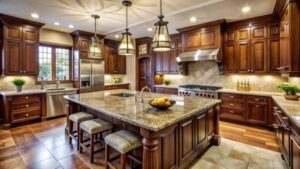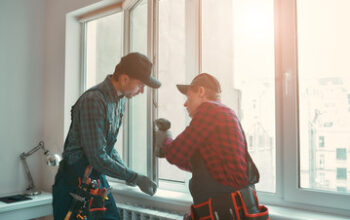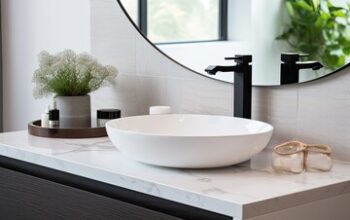Cabinet Refacing Sacramento CA is an affordable, budget-friendly alternative to replacing cabinets. It takes less time to complete and doesn’t disrupt daily life the way a full remodel can.
Refacing transforms cabinet interiors and exteriors for a cohesive appearance that cannot be achieved by painting alone. However, it won’t improve underlying cabinet problems such as sagging shelves or poorly secured joints.
Cabinet refacing is a cost-effective way to give your kitchen a fresh new look without the expense of replacement. It’s also a great option for homeowners looking to increase home value without undergoing an extensive remodeling project. A professional contractor can provide you with a wide range of design and color options. They will help you determine which material best suits your style and budget. Some of the most popular choices are wood, PVC vinyl, and rigid thermofoil (RTF).
The cost of refacing your cabinets depends on several factors. The first step is to determine the type of material you would like to use, which can vary in price. You can also choose to incorporate additional upgrades, such as drawer upgrades or convenient storage options. It’s important to remember that any additional work will add to the overall cost of the refacing project.
Refacing is more economical than a complete replacement, but it is still a significant investment. Labor costs can be expensive, so it’s important to get quotes from several contractors. This will ensure that you’re getting the best value for your money.
While the initial investment may be more expensive than a full replacement, cabinet refacing can save you thousands of dollars in the long run. It’s also a more environmentally friendly alternative to replacing cabinets entirely, as it reduces landfill waste.
In addition to the cost of materials, you should consider other costs associated with the refacing project, such as removal and disposal of existing hardware and installation of the new doors and drawer fronts. Additionally, you may need to purchase extra hardware or upgrade to soft-close hinges. Choosing the right cabinet door material is crucial for the success of your refacing project. It’s important to choose a material that is durable, affordable, and easy to maintain.
There are many different cabinet refacing materials, each with their own benefits and disadvantages. Solid wood offers a luxurious aesthetic that complements a variety of styles, but it’s also more costly than other material options. It requires regular maintenance with specialized cleaners and polishes, as well as moisture control.
Durability
Cabinet refacing offers an alternative to full kitchen replacement, providing a fresh appearance for your cabinets without the hassle and expense of a major renovation. The process involves covering existing cabinet doors, drawer fronts, and box exteriors with premium 3D laminate, while preserving the sturdy framework underneath. It can significantly enhance your kitchen’s aesthetics, while improving efficiency and addressing any functional issues. The durability of your refacing project depends on the materials used and how often they’re used.
Different material options offer a variety of design choices, from rustic to modern. A professional contractor will help you select the right material for your unique aesthetic and functional goals. For example, solid wood veneers tend to favor traditional styles, while PVC vinyl is ideal for contemporary designs. Depending on the material you choose, you can customize it further with a variety of finishes and colors.
Choosing the best materials for your refacing project will make all the difference in its longevity. Laminates, for example, are a budget-friendly choice that is easy to clean and durable. They also come in a range of patterns and colors, including some that mimic the appearance of natural wood or stone. Solid wood is more expensive but offers a luxurious aesthetic that complements a wide range of kitchen styles. However, it requires more maintenance than other options, and is prone to humidity damage.
The type of finish you select will also impact your cabinet refacing’s durability. For example, oil-based stains provide better protection against moisture and heat than water-based ones. A semi-gloss finish will also be easier to maintain than a satin or gloss finish.
Another important factor is the installation process. A reputable installer will use high-quality materials and skilled craftsmanship to ensure your new cabinet refacing is long-lasting. This will minimize the likelihood of defects and damage, as well as prevent warping or fading over time.
Refacing is also a more environmentally friendly option than replacing your cabinets. It reduces waste and preserves the existing framework, which cuts down on energy usage and landfill disposal. In addition, it doesn’t require tearing down and rebuilding your existing structure, which saves on labor and construction costs.
Appearance
Cabinet refacing is a great way to give your kitchen a facelift without spending a fortune. It involves replacing the cabinet doors and drawer fronts while retaining the existing cabinet boxes. This can be done in a variety of styles and colors, giving you the perfect look for your kitchen. The type of finish used in a cabinet refacing project also impacts the durability and appearance of the cabinets. Here are some of the options available:
Refacing is a cost-effective alternative to resurfacing and painting, but it doesn’t fix issues with the overall layout or floor plan. Moreover, it can’t change the structural integrity of your cabinets, such as sagging shelves or weak joints in the drawer box. This can result in moisture damage over time, leading to rotting and other problems.
In addition to affecting the overall look of your kitchen, the type of finish you choose will impact how easily your cabinets can be cleaned and maintained. Some finishes, such as wood veneers, are more durable than others and can be resurfaced when needed. However, some materials require specialized care and maintenance, such as regular polishing and protection against heat and water damage.
When choosing a finish for your cabinet refacing, consider its durability, ease of cleaning, and the style of your home. For example, matte finishes are popular because they offer a clean, contemporary look that complements many design styles. They are also less likely to show smudges or fingerprints, making them ideal for high-traffic areas.
There are several different types of materials available for cabinet refacing, including wood veneers, rigid thermofoil (RTF), and plastic laminates. Each option offers unique advantages and disadvantages. For example, wood veneers are prone to scratches and water damage, while RTF is waterproof and more durable.
NHance’s Color Shift process is an excellent option for homeowners who want their cabinets to have a more custom, handmade look. This process includes applying multiple coats of color to your wooden surfaces by hand. This is a time-consuming, labor-intensive process, but it can provide a dramatic new look for your kitchen.
Installation
Cabinet refacing requires specialized tools to be properly completed. This type of installation is less invasive than replacing cabinets, but still demands attention to detail in order to ensure a finished look that is both beautiful and durable. Depending on the type of refacing, different materials are used to cover exposed cabinet surfaces. Some methods use wood veneer, while others use laminate or other materials. Wood veneer is less durable than solid wood and can crack and swell when it comes into contact with water. It is also susceptible to warping, which can affect the appearance of a kitchen over time. Laminate, on the other hand, is a more durable material that can be used in high-moisture areas like bathrooms.
Cabinet facelifts are a great way to transform the look of an outdated kitchen. They can also help to increase the value of your home and are a cost-effective alternative to purchasing new cabinets. However, refacing your cabinets can be tricky and require the assistance of professional installers to avoid mistakes. A reputable installation service will be able to provide you with quality work that will last for years to come.
The process of refacing cabinets involves replacing cabinet doors, drawer fronts, hardware, and any other components that are not visible to the user. This method is much less labor intensive than replacing the cabinets, and it will typically save you up to 50% compared to replacement costs. However, it is important to note that you may need to purchase additional parts to complete the project, including hinges and handles.
Before you begin the refacing process, it is important to evaluate the condition of your cabinet boxes and determine whether they are structurally sound. It is also necessary to gather the required materials, such as new cabinet doors and drawer fronts, veneer, glue, and hardware. Once you have gathered all the necessary items, it is important to prepare the cabinet boxes by cleaning them and sanding the exposed surfaces. This will help to create a smooth surface for the application of the veneer and will also prevent moisture from damaging the cabinet boxes.


